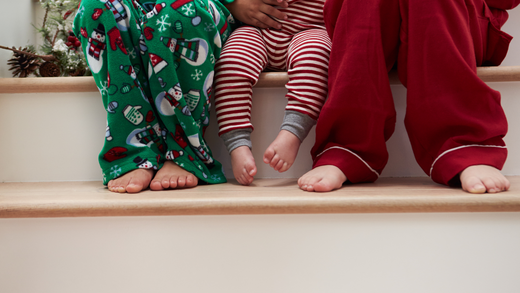Toddlers are naturally curious, and stairs are one of the most dangerous areas in the home.
To address this, knowing how to child proof stairs is essential—start by installing baby gates, securing handrails, removing tripping hazards, and applying carpet stair treads for added grip and protection.
These simple adjustments can significantly reduce fall risks and make your home safer for your child.
In this article, you’ll learn exactly how to protect your stairs step by step, including when and how to transition from gates to carpet stair treads as your child grows.
We’ll also cover how to adapt these solutions for modern staircases and floating stair designs.
Whether you're new to childproofing or ready for the next phase, this guide has you covered.
Why It’s So Important to Child Proof Stairs
Falls are one of the leading causes of injury in toddlers, and stairs are one of the biggest hazards inside the home.
According to the Juvenile Products Manufacturers Association, stair-related falls are a top cause of unintentional injuries in children under five.
Toddlers are curious by nature.
They want to explore their surroundings and test their independence, but they haven’t developed the balance or spatial awareness to do so safely.
That’s where stair safety comes in.
By child proofing your stairs early on, you can give your child the freedom to explore while reducing your risk of injury and creating peace of mind for yourself as a parent.
Step 1: Install Baby Gates for the Highest Level of Protection
Your first line of defense is physical barriers.
Top and Bottom Gates
Install secure baby gates at both the top and bottom of your stairs.
Use hardware-mounted gates for the most secure fit—these attach directly into the wall and are much harder for toddlers to dislodge than pressure-mounted models.
Avoid accordion-style gates or gates with large openings that small hands or feet can get stuck in.
Choose the Right Height
Gates should be at least 22 inches tall and should not have gaps wide enough for a child to squeeze through or get caught in.
Look for models that meet current safety standards and that are difficult for toddlers to open.
Step 2: Secure Railings, Banisters, and Edges
Once your child starts pulling themselves up or walking on their own, they’ll likely reach for whatever is nearby for support—including your stair railings.
Check for Stability
Walk your staircase yourself and wiggle the railings and banisters.
Tighten any loose hardware and ensure there are no wobbling spindles or rails that could be pulled off.
Add Guards if Needed
If your banisters have wide openings, install a safety net or clear plastic banister guard to prevent your child from slipping through.
You can find these online or at most baby supply stores.
Soften Hard Edges
Use corner guards or foam padding on any hard edges to soften impact in case of a trip or fall.
Step 3: Keep the Stairs Clear
One of the easiest ways to improve stair safety is by removing tripping hazards.
No Toys, No Clutter
Make it a rule that no toys, shoes, bags, or laundry items are ever left on the stairs. These can easily become slip or trip hazards—especially for kids who aren’t steady on their feet.
Remove Rugs and Mats
Loose rugs or runners near the top or bottom of stairs can slide out from underfoot. Either secure them with proper adhesive or remove them entirely.
Step 4: Transition from Baby Gates to Stair Treads
As your child grows and becomes more confident walking or climbing stairs with your help, it’s a good time to think about transitioning away from baby gates.
Why Carpet Stair Treads Work
Carpet stair treads provide grip and traction on each step, which helps reduce slipping.
They also offer a softer landing surface in case of a fall, and they create a visual guide that can help toddlers understand where each step begins and ends.
When to Make the Switch
Start the transition when your child can:
-
Climb up and down while holding a handrail.
-
Follow basic stair safety instructions.
-
Show consistent balance on level surfaces.
This usually happens between 18 months and 3 years, but every child is different.
Oak Valley Stair Treads: Safe, Stylish, and Easy to Install
At Oak Valley Designs, we specialize in handcrafted carpet stair treads that are made with families in mind.
Our treads feature sewn-in padding, pet-friendly materials, and peel-and-stick adhesive backing—making them safe, secure, and simple to install.
Plus, they’re made right here in Georgia using high-quality materials sourced from trusted U.S. partners like Shaw and J Mish.
You can skip the messy carpet tape or hardware and still get a professional-looking result in minutes.
They’re an ideal solution for any parent who wants both peace of mind and elevated design.
Step 5: Teach Your Child How to Use Stairs Safely
No matter what safety measures you install, teaching your child good stair habits is essential.
Supervise First, Then Practice
Stay close and provide support when your toddler first starts climbing stairs. Encourage them to go slowly, use the handrail, and always take one step at a time.
Create a Routine
Repetition helps. Use the same phrases every time (“One step at a time,” “Hold the rail,” etc.) to help them remember what to do. Praise them when they follow the rules correctly.
Discourage Play on the Stairs
Make it clear that stairs are not a place to play, run, or jump. You can even use visual cues like soft decals or tape to mark off where they can and can’t go.
How to Maintain Your Child-Proofed Stairs
Safety isn’t just about what you install—it’s also about upkeep.
Inspect Regularly
Check baby gates weekly to make sure they’re still tightly secured.
Inspect railings and stair treads every month for signs of wear or looseness.
Replace any damaged components immediately.
Clean Stair Treads
If you’ve installed carpet stair treads, vacuum them regularly and clean up spills promptly.
This keeps them grippy and extends their life.
Update as Your Child Grows
Your stair safety setup should evolve as your child does.
Gates might not be needed forever, but stair treads can continue to serve as a permanent slip-resistant feature even when your child is older.
What About Modern Homes? How to Child Proof Floating Stairs
If you live in a newer or custom-built home, you may have an open or minimalist staircase design—sometimes called floating stairs.
These look stunning, but they can be a major challenge when it comes to childproofing.
To child proof floating stairs, use many of the same techniques as traditional stairs.
Start by installing secure baby gates at the top and bottom of the staircase.
Then inspect the handrails and sides of the staircase.
Many floating stairs have open sides or horizontal rails that make them easy for children to slip through.
You can child proof floating stairs by adding acrylic or Plexiglas panels to the sides or installing stair guards to block access to the gaps.
Carpet stair treads are also especially helpful in floating stair designs, where wood or metal steps are slippery by default.
The goal is to maintain your home’s modern aesthetic while quietly adding safety—without bulky gear or unattractive barriers.
Enhancing Safety with Extra Features
Once the basics are covered, consider adding a few more enhancements for peace of mind.
Good Lighting
Proper lighting makes a huge difference in how well your child can see each step.
Install nightlights or motion-sensor lights on staircases to improve visibility—especially for early risers or night-time bathroom trips.
Non-Slip Finishes
If you have wood stairs, consider adding a non-slip finish underneath your stair treads.
This adds another layer of grip and reduces the chance of treads shifting over time.
Non-Toxic Materials
Make sure any adhesives, padding, or materials you’re using are free from harmful chemicals.
Oak Valley Designs uses eco-conscious materials that are safe for both kids and pets.
Steps To Success
Childproofing stairs may seem like a big task, but each adjustment you make helps protect your child from harm.
Start with physical barriers like baby gates, secure your handrails, clear away hazards, and use carpet stair treads to reduce slips.
As your toddler becomes more independent, you’ll be glad you took the time to put safety measures in place—and even more glad you found a solution that works with your home’s design, not against it.
Oak Valley Designs offers luxurious, family-friendly stair tread options made with love and built to last.
Whether you’re working with traditional steps or looking to child proof floating stairs, we’re here to help you find a beautiful solution that works.
Ready to upgrade your home with safe, stylish stair treads?
Contact Us Today!
Explore high-quality stair grips handcrafted in the USA by Oak Valley Designs.
Make your stairs safer, more stylish, and built for everyday life.
-
Website: https://oakvalleydesigns.com/
-
Phone: 706.331.0315
-
Email: info@oakvalleydesigns.com
-
Address: 30 River Ct SW Bldg E Cartersville, Ga 30120




